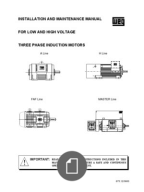📘 قراءة كتاب Maintenance & Repair - Module 1 أونلاين


know different “Maintenance Strategies” and “Condition Monitoring” Tools
• know the importance of “Preventive Maintenance Schedule”, “Maintenance Log” and “Repair History
Log”.
• know the principles and how to install and maintain different mechanical drives: Belt Drives,
Chain Drives, and Enclosed Gear Drives.
• know the classification and the most common shaft couplings
• align shafts for the installation of couplings using different methods.
• know the hazards during maintaining mechanical drives and know how to work safe.
• calculate speeds for belt drives, chain drives and gear drives.
COURSE OUTLINE
THEORY
( 50 % )
HANDS-ON TRAINING
( 50 % )
METHOD
• Maintenance Strategies
• Condition Monitoring Tools
• Preventive Maintenance Schedule
• Maintenance Log and History files
• Typical mechanical drives and their
accessories
• Maintaining different kinds of
drives
• Types of check: lubrication,
temperature, and vibration.
• Alignment methods of mechanical
drives
• Applied Mathematics
• Work out the advantages/disadvantages
of Maintenance
Strategies
• Align a typical disk coupling using
the coupling alignment trainer
• Install at least two complete mechanical
drives on a base plate (electric
motor, reducer, chain drive and
electric motor, reducer, belt drive)
• Make use of different couplings
• Align all shafts and make a test run
• Exercises in Mathematics
• Lectures/Discussion
• Practical Sessions
• Teaching Video
Maintenance & Repair Module 1
Table of Contents
Chapter Topic Page
1. Maintenance Management 1
1.1 Types of Maintenance Strategies 1
1.2 Shift from Unscheduled Work to Scheduled Work 2
1.3 Preventive Maintenance Schedule 2
1.4 Maintenance Log 3
1.5 Repair History Log 3
Equipment File 4
1.6 Condition Monitoring – 7 Tools, Effectiveness of Lubrication Analysis 5
1.6.1 Lubrication Analysis 6
1.6.2 Vibration Analysis 6
1.6.3 Thermography 7
2. Belt Drive 8
2.1 Flat Belt Drive 8
2.2 V-Belt Drive 9
2.2.1 Installation of V-Belt Drive 9
2.2.2 Maintenance Principles for V-Belt Drives 10
V-Belt Drive Troubleshoot 11
2.3 Positive Drive Belts 11
3. Chain Drive 13
3.1 Sprocket 13
3.2 Chain 14
3.2.1 Roller Chain Layout 14
3.2.2 Roller Chain Installation 14
3.2.3 Roller Chain Lubrication 15
3.2.4 Roller Chain Maintenance 16
3.2.5 Roller Chain Dimension 17
4. Enclosed Gear Drive Maintenance 18
4.1 Gear Drive Installation 18
4.1.1 Floor Mounting 18
Maintenance & Repair Module 1
4.1.2 Structural Mounting 18
4.1.3 Leveling and Fixing 18
4.1.4 Installation the Accessories 18
4.1.5 Lubricate before Test-Run 19
4.1.6 Test Run (no load test) 19
4.1.7 Run-In 19
4.1.8 Condition Monitoring 19
4.1.9 Storage 19
4.2 Troubleshooting for Enclosed Gear Drives 20
5. Shaft Couplings 21
5.1 Classification of Couplings 21
5.1.1 Rigid Couplings 21
5.1.2 Flexible Couplings 22
5.1.3 Elastic Couplings 23
5.2 Proper Coupling Selection 24
6. Shaft Alignment 25
6.1 Alignment Procedure 26
6.1.1 Mounting Foot – Leveling 26
6.1.2 Alignment of Coupling Faces (Dial Gauge & Feeler Gauge Method) 27
6.1.3 Alignment of Coupling Contour – Horizontal 28
6.1.4 Alignment of Coupling Contour – Parallel 29
6.1.5 Adjusting the Gap 29
Exercise for Shaft Alignment 30
7. Safety Precautions for the Maintenance of Mechanical Drives 31
8. Calculation of Speed for V-Belt & Gear Drives 32
8.1 Single V-Belt Drive 32
8.2 Gear Drive
repair pdf
mechanical maintenance handbook
types of maintenance pdf
mtbf calculation example
انواع الصيانة الميكانيكية pdf
تحميل وقراءة وتصفح أولاين مباشر بدون روابط كتاب مكونات وحدة التغذية واهم الاعطال واصلاحها pdf
حجم الكتاب عند التحميل : 1.4 ميجا بايت .
نوع الكتاب : pdf.
عداد القراءة:
اذا اعجبك الكتاب فضلاً اضغط على أعجبني و يمكنك تحميله من هنا:

شكرًا لمساهمتكم
شكراً لمساهمتكم معنا في الإرتقاء بمستوى المكتبة ، يمكنكم االتبليغ عن اخطاء او سوء اختيار للكتب وتصنيفها ومحتواها ، أو كتاب يُمنع نشره ، او محمي بحقوق طبع ونشر ، فضلاً قم بالتبليغ عن الكتاب المُخالف:
 قبل تحميل الكتاب ..
قبل تحميل الكتاب ..
يجب ان يتوفر لديكم برنامج تشغيل وقراءة ملفات pdf
يمكن تحميلة من هنا 'http://get.adobe.com/reader/'


 منصّة المكتبة
منصّة المكتبة